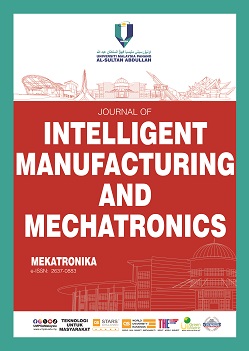Pill Recognition via Deep Learning Approaches
DOI:
https://doi.org/10.15282/mekatronika.v6i2.11020Keywords:
Pill recognition, Deep learning, Pharmaceutical, Image processing, Pill imaging, YOLOv8Abstract
Deep learning significantly transforms pill imaging recognition in the healthcare and pharmaceutical industries by automating the identification and classification processes based on visual indicators. It is important to develop a robust deep learning framework to ensure the accurate dispensing of medications. The features such as size, color, shape, markings and text imprint are scrutinized by these methods. However, real-world matching is difficult due to factors like the similarity of pill forms and the scarcity of databases. The goal of this work is to improve deep learning models for better classification of pill images. A dataset of 994 images are utilized from a public pharmaceutical database which sorted by 20 common type of pills. These images were split into training, validation, and testing sets in a 70:15:15 ratio. There are three different models which are YOLOv3, YOLOv5, and YOLOv8 were employed to the system. These models use performance metrics like recall, mean Average Precision (mAP), and precision as results. According to our results, YOLOv8 did remarkably well, obtaining a precision and F1-score of 99.17% and 96.95%, respectively, while YOLOv5 great with mAP and recall of 94.83% and 95%, respectively, outperforming the YOLOv3 model. The success of YOLOv8 underscores its significance in reducing medical errors with its accurate, real-time capabilities for identifying pills. The use of artificial intelligence in pill recognition not only lowers the chance of incorrect medication use but also streamlines the duties of healthcare professionals. This shift allows them to prioritize crucial responsibilities and simplifies the process of pill identification.
References
[1] S. S. Kar, H. S. Pradhan, and G. P. Mohanta, “Concept of essential medicines and rational use in public health,” Indian J. Community Med., vol. 35, no. 1, pp. 10–13, 2010, doi: 10.4103/0970-0218.62546.
[2] S. Sultana, “History of Contraception,” J. Islam. Int. Med. Coll., vol. 14, no. 4, pp. 172–173, 2019, doi: 10.32440/ar.2018.135.01.rev09.
[3] M. Janczura, S. Sip, and J. Cielecka-Piontek, “The Development of Innovative Dosage Forms of the Fixed-Dose Combination of Active Pharmaceutical Ingredients,” Pharmaceutics, vol. 14, no. 4, 2022, doi: 10.3390/pharmaceutics14040834.
[4] E. Nabrawi and A. T. Alanazi, “Imaging in Healthcare: A Glance at the Present and a Glimpse Into the Future,” Cureus, vol. 15, no. 3, 2023, doi: 10.7759/cureus.36111.
[5] C. O. Airhihenbuwa, T. S. Tseng, V. D. Sutton, and L. S. Price, “Global Perspectives on Improving Chronic Disease Prevention and Management in Diverse Settings,” Prev. Chronic Dis., vol. 18, no. December 2020, pp. 1–7, 2021, doi: 10.5888/PCD18.210055.
[6] Y. Zheng et al., “Designing Human-Centered AI to Prevent Medication Dispensing Errors: Focus Group Study With Pharmacists,” JMIR Form. Res., vol. 7, no. 1, pp. 1–15, 2023, doi: 10.2196/51921.
[7] C. Chakraborty, M. Bhattacharya, S. Pal, and S. S. Lee, “From machine learning to deep learning: Advances of the recent data-driven paradigm shift in medicine and healthcare,” Curr. Res. Biotechnol., vol. 7, no. November 2023, p. 100164, 2024, doi: 10.1016/j.crbiot.2023.100164.
[8] A. R. Ashraf, A. Somogyi-Végh, S. Merczel, N. Gyimesi, and A. Fittler, “Leveraging code-free deep learning for pill recognition in clinical settings: A multicenter, real-world study of performance across multiple platforms,” Artif. Intell. Med., vol. 150, no. June 2023, 2024, doi: 10.1016/j.artmed.2024.102844.
[9] J. Heo, Y. Kang, S. K. Lee, D. H. Jeong, and K. M. Kim, “An Accurate Deep Learning–Based System for Automatic Pill Identification: Model Development and Validation,” J. Med. Internet Res., vol. 25, 2023, doi: 10.2196/41043.
[10] E. Y. Fung, B. Leung, D. Hamilton, and J. Hope, “Do automated dispensing machines improve patient safety?,” Can. J. Hosp. Pharm., vol. 62, no. 6, pp. 516–519, 2009, doi: 10.4212/cjhp.v62i6.852.
[11] S. S. Gomasta, A. Dhali, T. Tahlil, M. M. Anwar, and A. B. M. S. Ali, “PharmaChain: Blockchain-based drug supply chain provenance verification system,” Heliyon, vol. 9, no. 7, p. e17957, 2023, doi: 10.1016/j.heliyon.2023.e17957.
[12] S. Walker, “Foreword by Professor Stuart Walker,” Int. Coop. Converg. Harmon. Pharm. Regul., pp. xvii–xviii, 2014, doi: 10.1016/b978-0-12-800053-3.06001-8.
[13] J. Kufel et al., “What Is Machine Learning, Artificial Neural Networks and Deep Learning?—Examples of Practical Applications in Medicine,” Diagnostics, vol. 13, no. 15, 2023, doi: 10.3390/diagnostics13152582.
[14] Y. LeCun, Y. Bengio, and G. Hinton, “Deep learning,” Nature, vol. 521, no. 7553, pp. 436–444, 2015, doi: 10.1038/nature14539.
[15] Y. Zhu, R. Urtasun, R. Salakhutdinov, and S. Fidler, “SegDeepM: Exploiting segmentation and context in deep neural networks for object detection,” Proc. IEEE Comput. Soc. Conf. Comput. Vis. Pattern Recognit., vol. 07-12-June, pp. 4703–4711, 2015, doi: 10.1109/CVPR.2015.7299102.
[16] L. Alzubaidi et al., Review of deep learning: concepts, CNN architectures, challenges, applications, future directions, vol. 8, no. 1. Springer International Publishing, 2021. doi: 10.1186/s40537-021-00444-8.
[17] S. B. Junaid et al., “Recent Advancements in Emerging Technologies for Healthcare Management Systems: A Survey,” Healthc., vol. 10, no. 10, 2022, doi: 10.3390/healthcare10101940.
[18] A. Salam and N. Abhinesh, “Revolutionizing dermatology: The role of artificial intelligence in clinical practice,” IP Indian J. Clin. Exp. Dermatology, vol. 10, no. 2, pp. 107–112, 2024, doi: 10.18231/j.ijced.2024.021.
[19] P. T. Wu, T. Y. Sun, J. C. Lin, and C. L. Chin, “Round Pill Shape Recognition System Based on AY Deep Learning Model,” in Proceedings - 2022 IEEE International Conference on Consumer Electronics - Taiwan, ICCE-Taiwan 2022, Institute of Electrical and Electronics Engineers Inc., 2022, pp. 553–554. doi: 10.1109/ICCE-Taiwan55306.2022.9869124.
[20] L. Tan, T. Huangfu, L. Wu, and W. Chen, “Comparison of RetinaNet, SSD, and YOLO v3 for real-time pill identification,” BMC Med. Inform. Decis. Mak., vol. 21, no. 1, Dec. 2021, doi: 10.1186/s12911-021-01691-8.
[21] A. D. Nguyen, H. H. Pham, H. T. Trung, Q. V. H. Nguyen, T. N. Truong, and P. Le Nguyen, “High accurate and explainable multi-pill detection framework with graph neural network-assisted multimodal data fusion,” PLoS One, vol. 18, no. 9 September, Sep. 2023, doi: 10.1371/journal.pone.0291865.
Downloads
Published
Issue
Section
License
Copyright (c) 2024 The Author(s)

This work is licensed under a Creative Commons Attribution-NonCommercial 4.0 International License.




